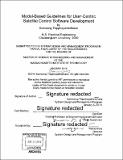| dc.contributor.advisor | Dov Dori. | en_US |
| dc.contributor.author | Thipphayathetthana, Somwang | en_US |
| dc.contributor.other | System Design and Management Program. | en_US |
| dc.date.accessioned | 2016-11-14T19:06:35Z | |
| dc.date.available | 2016-11-14T19:06:35Z | |
| dc.date.copyright | 2015 | en_US |
| dc.date.issued | 2015 | en_US |
| dc.identifier.uri | http://hdl.handle.net/1721.1/105320 | |
| dc.description | Thesis: S.M. in Engineering and Management, Massachusetts Institute of Technology, Engineering Systems Division, 2015. | en_US |
| dc.description | Cataloged from PDF version of thesis. | en_US |
| dc.description | Includes bibliographical references (page 45). | en_US |
| dc.description.abstract | Three persistent common problems in satellite ground control software used by satellite controllers are obsolescence, lack of desired features and flexibilities, and endless software bug fixing. The obsolescence problem occurs when computer and ground equipment hardware become obsolete usually after only one third into the satellite mission lifetime. The satellite ground control software needs to be updated to accommodate changes on the hardware side, requiring significant work of satellite operators to test, verify, and validate these software updates. Software updates can also result from a new software version that offers new features or just fixes some bugs. Trying to help solve these problems, an OPM model and guidelines for developing satellite ground control software have been proposed. The system makes use of a database-driven application and concepts of object-process orientation and modularity. In the new proposed framework, instead of coding each software function separately, the common base functions will be coded, and combining them in various ways will provide the different required functions. The formation and combination of these base functions will be governed by the main code, definitions, and database parameters. These design principles will make sure that the new software framework would provide satellite operators with the flexibility to create new features, and enable software developer to find bugs quicker and fix them more effectively. | en_US |
| dc.description.statementofresponsibility | by Somwang Thipphayathetthana. | en_US |
| dc.format.extent | 45 pages | en_US |
| dc.language.iso | eng | en_US |
| dc.publisher | Massachusetts Institute of Technology | en_US |
| dc.rights | M.I.T. theses are protected by copyright. They may be viewed from this source for any purpose, but reproduction or distribution in any format is prohibited without written permission. See provided URL for inquiries about permission. | en_US |
| dc.rights.uri | http://dspace.mit.edu/handle/1721.1/7582 | en_US |
| dc.subject | Engineering Systems Division. | en_US |
| dc.subject | System Design and Management Program. | en_US |
| dc.title | Model-based guidelines for user-centric satellite control software development | en_US |
| dc.type | Thesis | en_US |
| dc.description.degree | S.M. in Engineering and Management | en_US |
| dc.contributor.department | System Design and Management Program. | en_US |
| dc.contributor.department | Massachusetts Institute of Technology. Engineering Systems Division | |
| dc.identifier.oclc | 962366134 | en_US |
